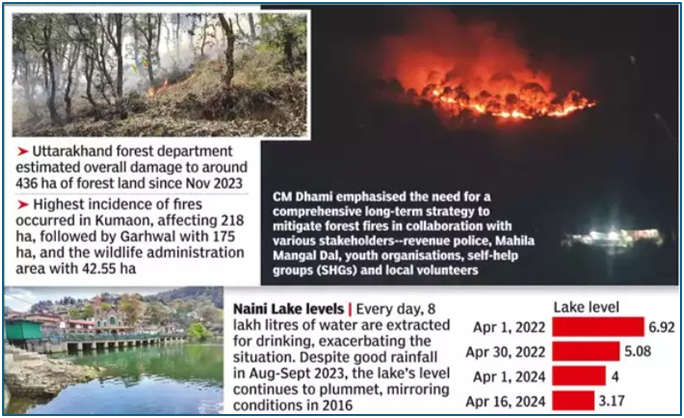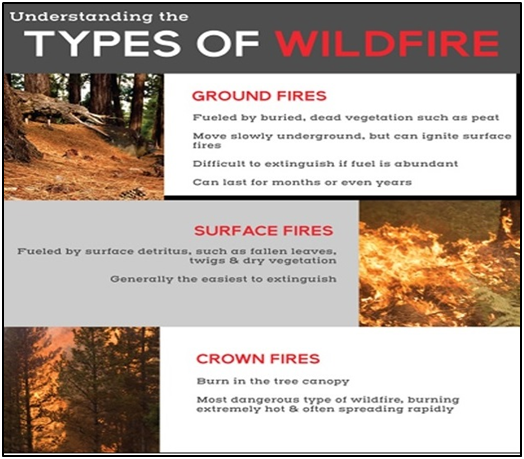Why in news?
A massive fire is spreading through the forests near Nainital in Uttarakhand. It has been burning for 60 hours, leading to the deployment of Indian Air Force personnel and Mi-17 choppers in an effort to quell the raging fire. According to the officials, these forest fires have gutted over 142 hectares of forest land in the State.

What’s in today’s article?
- Forest Fires/Wildfires
- Why is Uttarakhand an easy target for forest fire?
- How can forest fires be tackled?
What are Forest Fires/Wildfires?
- It is an unplanned, uncontrolled & unpredictable fire in an area of combustible vegetation.
- Causes:
- These include natural (lightning, high atmospheric temperatures and low humidity (dryness) and man-made (agricultural practices like Jhum, a source of fire (cigarette, bidi, etc)].
- Three conditions must be present in order for any fire to exist: fuel, oxygen and a heat source. This is often referred to as the fire triangle.
- In the case of a forest, oxygen is in ample supply, and fuel is supplied in the form of dry trees, shrubs, grasses and litter - particularly in the dry, hot summer months.
- Dry weather, drought and dry vegetation can offer easy kindling for a fire. Strong winds further help the spread of a forest fire.
- As per a 2019 report from the Forest Research Institute, 95% of forest fires are caused by humans.
- Often, grazers set fire to dry grass in the hopes of encouraging the cultivation of new grass.
- Slash and burn and shifting cultivation also use fire. Unattended campfires, burning of waste, lit cigarette stubs as well as intentional lighting of fires with criminal intent are some other man-made causes.
- Natural causes included the rubbing of dry trees or bamboo, sparks set off by stones, or lightning.
- Types of forest fire:

Why is Uttarakhand an easy target for forest fire?
- Vulnerability of Indian forests
- According to the report of the Forest Survey of India, over 54% of the forest cover in India is exposed to occasional fire.
- There are four forest-fire clusters in India- the North-Western Himalayas, North-East India, Central Ghats, and Western and Eastern Ghats.
- Situation in North-Western Himalayas
- Fires in the North-Western Himalayas are attributed to the preponderance of pine trees and the accumulation of thick flammable litter.
- In the summer, there is a large quantity of pine needles that gathers on the forest floor, which is highly susceptible to fire.
- The occurrence of high fire intensity at the low altitude Himalayan hilly regions may also be due to the proximity to villages.
- Villages make forests susceptible to anthropogenic activities like forest cover clearance, grazing and so on.
- Sharp increase in average and maximum air temperature, decline in precipitation, and change in land-use patterns have also caused increasing episodes of forest fires in this region.
- Local community patterns are also responsible for instances of forest fire.
How can forest fires be tackled?
- Awareness and controlled burning
- Besides spreading awareness, there are certain measures that can be undertaken to reduce the incidence of forest fire.
- This includes the removal of biomass through controlled or prescribed burning.
- Limited and controlled forest burns have been shown to be useful in promoting healthy forest growth, getting rid of undergrowth, dead trees and litter. Fresh healthy plants replace such areas.
- Once a patch of land is burned or cleared of dried biomass by a ground-fire, it is difficult for another fire to occur there.
- This process is usually done by taking 5.2-metre-wide fire-lines or fire-belts in forested areas to which people have access.
- Other preventive steps
- Engaging temporary fire watchers, desilting of water sources within the forest, and having fire safety equipment at hand.
- Increase surveillance of forests using drones
- Steps taken by the govt
- A satellite-based fire alert system introduced by the Forest Survey of India. This makes it easy for staff to find out whether there are fires inside the forest.
- Forest staff use methods like beating the fire with green, leafy boughs, and counter-fires. They also carry fire beaters and blowers.










